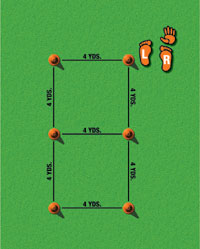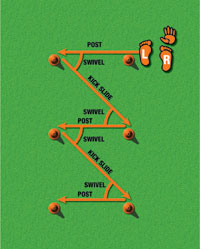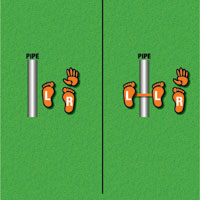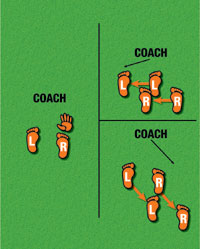AMERICAN FOOTBALL MONTHLY THE #1 RESOURCE FOR FOOTBALL COACHES
Article CategoriesAFM Magazine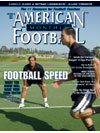
|
Technique Over TalentThe Bengals’ Paul Alexander uses a system to develop his Linemen by focusing on the technical aspect of O-line play.by: Michael Parker © More from this issue Coaching legend Bill Walsh has said that the essence of coaching is isolating the skills necessary to play a position and then finding the best way to teach those skills. And no position is more in need of solid skills than the offensive line. Longtime Cincinnati Bengal offensive line coach Paul Alexander has become known as one of the best technical experts in offensive line play. He has distilled the skills required for consistently solid linemen and has a system in place that consequently hones those skills. Alexander knows that at the highest level of football, the difference in success and failure is often not as much in talent as in technique. “NFL players survive on talent and fundamentals. We do not assume that pro players have mastered the fundamentals. We teach and drill the basics. We emphasize STANCE, FOOTWORK, LEVERAGE, HAND PLACEMENT, ANGLES and FINISH. We teach the C/QB exchange and take nothing for granted. We like to emphasize execution. When you can execute your plays better than the defense executes their defenses, the ball moves down the field,” says Alexander. Like all successful coaches, Alexander believes in starting at the beginning. Just because the players he coaches have reached football’s ultimate level doesn’t mean that they can’t benefit from working on the basics of the game. In the NFL, where every team has players who are talented, execution often is the difference maker. At this level, no team just overpowers their opponent. TEACHING STANCE Stance isn’t just a pre-snap technique. Alexander says this is “perhaps the essence of coaching NFL offensive linemen. Most guys come from college needing to learn how to effectively use their hips to generate power. We do every drill we can invent to get the players to have their feet slightly wider than the hips, feet flat on the ground, toes slightly out with the knees bent, an arch in the back and staggered feet.” Alexander tracks stance throughout the blocking of the play to ensure that his players are in the best possible position to succeed. A few principles for proper stance: • “Feet are flat.” • “Toes are slightly out.” • “Feet are outside the hips throughout drive blocking and pass protection.” • “Insteps provide pressure points with the ground keeping the hips centered like tent stakes keep a tent solid during a wind storm.” • “Arch in the lower back.” TEACHING FOOTWORK Without good footwork, an offensive lineman’s strength is irrelevant. The Bengals focus on footwork first thing every day before practice in what Alexander calls his ‘Circuit Drill.’ “This is a four minute circuit that the players go through before practice. It sets the practice off mentally because it is a rehearsal of all the proper footwork used in blocking. Basically the circuit involves a re-direction drill, angled boards for base development, zig zag pass protection angle drill, pipe bird dogs for teaching players not to step underneath themselves and a pass protection spot drill. It is a unique, focused drill which has really helped our players develop proper footwork,” says Alexander. Here is a brief description from Alexander of each of the drills within the circuit. ALEXANDER’S CIRCUIT DRILL Watch Alexander’s O-Line Circuit Drill at www.AmericanFootballMonthly.com. Re-Direct Drill: “On cadence, player steps and the coach points right or left. The player learns to re-direct off his first step to adjust to the movement of the defender. Adjusting off a ‘read’ step requires balance and poise. We like to emphasize to the players, the very first drill of the day, that nothing is more important than balance and poise. Firing out like a maniac will ultimately get you beat.” (See Diagram 1)
Angled Boards: “Put the board on a 45 degree angle. Player takes a step to open his hips to his course (bucket step) and then waddles down the board. Right and left.” (See Diagram 2)
Zig-Zag: “In pass protection the footwork should be post (lateral shuffle) versus inside rushers and kick/slide (45 degrees) versus outside rushers. Have six cones four yards apart. This is a great drill for teaching linemen how to cover their angles while keeping their shoulders square.” (See Diagrams 3A and 3B)
Pipes: “We put four half inch plumbing pipes (not too thick) five yards apart. The player lines his foot against each pipe (parallel), assumes his stance and executes the footwork necessary for a cut-off, reach block, post step for pass pro and kick slide for pass pro. These pipes emphasize the importance of getting width with the first step so that you don’t step underneath yourself, perhaps the most important technical element of line play.” (See Diagram 4)
Spot Drill: “The best pass pro drill I know. The coach rushes the player, gives feints and moves to the point of the protector’s set location (spot). Great blockers (and we have some) have the focus, poise and determination to establish their ‘spot’ regardless of the defenders’ intentions.” (See Diagram 5)
TEACHING PROPER ANGLES Alexander spends a good amount of time educating his linemen on taking proper angles in attacking defenders. It can often be difficult for a lineman, starting in a three-point stance, to work to second-level defenders with an angle that gives them a chance to block an often quicker player. “For example, when blockers zone cut-off, we strike a line of departure from our split to a point one full man past the LB. Our first step opens our bodies through this course. This keeps us with a consistent phase regardless of the alignment of the LB and DL,” says Alexander. These angles are best practiced in a group/team period such as half-line or some sort of combo period. TEACHING LEVERAGE, HAND PLACEMENT AND FINISH Leverage, hand placement and finish all fit together and should be worked on – and polished – together. To practice these techniques, Alexander utilizes what he calls ‘Six-Point Explosions.’ These six-point explosions are done this way … • “Blocker should be on hands and knees versus a bag/defender.” • “Lunge, executing a front flipper technique.” • “Bring your hips as close to the bag as possible.” • “Rotate the forearm as if you are looking at a watch on your wrist and bring the flipper directly forward and through (don’t swing it).” ASKING COACH ALEXANDER ABOUT O-LINE PLAY Q. Are your practice drills and format the same in training camp as in regular season practices? A. Because our season is so grueling, the intensity of our drills are obviously more intense in training camp as players are trying to make the club and shake the rust off their bodies. We do repeat the drills during the season to stay sharp. Q. Do you take all five positions yourself during practice/meetings? If not, how are they split up? A. Bob Surace (Assistant Offensive Line Coach) works with our offensive line as well and does an exceptional job. He spends most of his time with the younger players which has been a real asset for us as guys have developed. Q. Are there different fundamentals that you would emphasize to the guards as opposed to the tackles? A. The biggest difference between center, guard and tackle is the understanding of back path and QB set location relative to the blockers. For example, we teach different pass sets for the centers, guards and tackles because their geometry is different based on their position relative to the QB. The same would be true in run blocking. The drive block is different for the center, guard and tackle because the back is in different relative positions. Q. What drills do you do every day? A. We do a series of specific daily drills. It includes a footwork circuit, chutes or sled, combination fit drills and pass protection fundamental drills. Q. Is there anything that you do in an off season format to improve the linemen’s fundamentals? A. Our ‘season’ really never ends, except for a few weeks during February. We work our daily drills for most of the year. In the off season, we spend time going through all the cut-ups with the players to identify specific areas of improvement for each player. Joe Bugel told me that Woody Hayes used to make his coaches identify three specific technical areas of improvement for each player during Spring Practice. I have always given my players, in writing, specific areas of improvement. They appreciate it. Q. How do you structure your time in practice? A. Pre-practice, we work C/QB exchange. Ken Zampese (QBs Coach) and I work specific plays, calls, etc., so that the QB can feel what the center is doing in all the different situations. We also work on audibles for the QB in this period. Next, we do the Circuit (see above). After stretch, we either go through the chutes or the sled. We work on some element of blocking as well. Some drills are six point explosions, flipper/hand development, cutoff angles, base development. This is a ten minute fundamental period. The next ten minutes are devoted to combination blocks or half line work. Later in practice during special teams, we do a series of pass protection drills that we alternate. Q. What is the most important part of offensive line play that you could share with coaches? A. Above my office/classroom door hangs a sign – “Through this door walk BIG, TUFF GUYS WHO LOVE FOOTBALL.” Nothing is more important than the drive to be great. |
|
| HOME |
MAGAZINE |
SUBSCRIBE | ONLINE COLUMNISTS | COACHING VIDEOS |
Copyright 2025, AmericanFootballMonthly.com
All Rights Reserved




